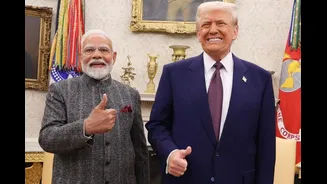Trade Overview
The trade relationship between India and the United States is substantial, reaching approximately $125 billion annually. India currently exports between $80
and $85 billion worth of goods to the US, while importing around $40 billion. This disparity in trade has resulted in a trade deficit for the United States. This deficit was addressed through the introduction of tariffs during the Trump administration. The current situation highlights the intricate balance and potential shifts that can occur in international trade partnerships, particularly when considering the diverse economic interests and policy approaches of the involved nations.
Sectoral Opportunities
While the specific sectors that might benefit from a renewed trade agreement are not provided, it is clear that various parts of the Indian economy could see an upswing in activity. Increased trade can stimulate growth in sectors like manufacturing, services, and technology. A reduction in tariffs or trade barriers, could lead to greater export volumes and increased revenues for Indian businesses. This opens up avenues for Indian companies to grow and expand their market reach. Understanding the types of industries that are likely to be affected will provide insight into the potential economic ramifications of a new trade deal between India and the US, benefiting both nations.
US Trade Deficit
The existing trade imbalance, where India exports significantly more to the US than it imports, has been a central issue in the relationship. A large US trade deficit has, at times, led to tensions and economic policies aimed at addressing the imbalance. One such response was the imposition of tariffs. These measures aimed to make imports more expensive and, hopefully, reduce the deficit. The future of the trade balance will depend on several factors, including the negotiation of a new agreement, changes in production costs and consumer preferences, and the broader global economic climate. Finding a more balanced trade relationship is a key objective for the US government.
Tariffs and Impact
The implementation of tariffs had a direct impact on trade dynamics. The tariffs affected the cost of goods moving between the two countries, influencing both import and export volumes. For Indian exporters, this could potentially make their products less competitive in the US market, thus decreasing sales and revenues. Similarly, US companies exporting to India may have faced higher costs. The imposition of tariffs highlighted the intricate nature of global trade and the potential for shifts in policy to significantly impact businesses operating across borders. Such measures underline the importance of navigating trade negotiations and creating policies that promote fair and reciprocal trade practices.
Future Prospects
Looking ahead, the evolution of the India-US trade relationship hinges on the outcome of discussions and negotiations. A new trade agreement could bring about notable changes. Reduced tariffs and streamlined trade procedures could increase commerce. The expansion of trade opportunities could offer benefits for companies in both India and the United States, encouraging economic growth and innovation. The future landscape depends not only on policy changes but also on the actions of businesses and the overall health of the global economy. This necessitates a proactive approach to trade relations, promoting collaboration and openness to maximize the benefits.















